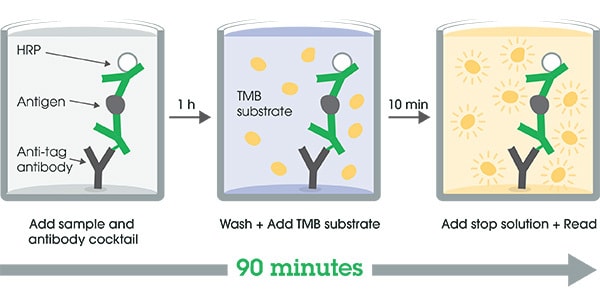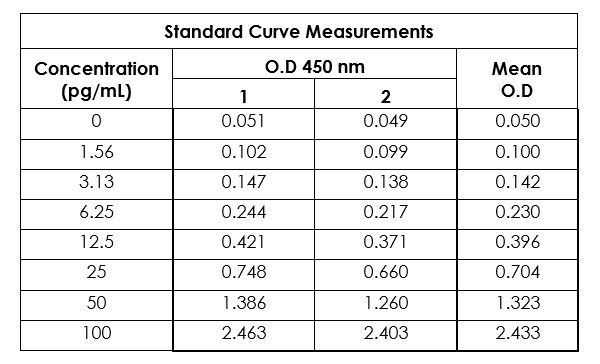Mouse IL-1 beta ELISA Kit (ab197742)
Key features and details
- One-wash 90 minute protocol
- Sensitivity: 1 pg/ml
- Range: 1.56 pg/ml - 100 pg/ml
- Sample type: Cell culture extracts, Cell culture supernatant, Cit plasma, Serum, Tissue Extracts, Urine
- Detection method: Colorimetric
- Assay type: Sandwich (quantitative)
- Reacts with: Mouse
Overview
-
Product name
Mouse IL-1 beta ELISA Kit
See all IL-1 beta kits -
Detection method
Colorimetric -
Precision
Intra-assay Sample n Mean SD CV% Overall 5 6.1% Inter-assay Sample n Mean SD CV% Overall 3 7.7% -
Sample type
Cell culture supernatant, Urine, Serum, Cell culture extracts, Tissue Extracts, Cit plasma -
Assay type
Sandwich (quantitative) -
Sensitivity
1 pg/ml -
Range
1.56 pg/ml - 100 pg/ml -
Recovery
Sample specific recovery Sample type Average % Range Cell culture supernatant 105 100% - 108% Urine 94 91% - 95% Serum 101 98% - 103% Plasma 89 78% - 95% Tissue Homogenate 97 95% - 100% -
Assay time
1h 30m -
Assay duration
One step assay -
Species reactivity
Reacts with: Mouse
Does not react with: Sheep, Cow -
Product overview
Mouse IL-1 beta ELISA Kit (ab197742) is a single-wash 90 min sandwich ELISA designed for the quantitative measurement of IL-1 beta protein in cell culture extracts, cell culture supernatant, cit plasma, serum, tissue extracts, and urine. It uses our proprietary SimpleStep ELISA® technology. Quantitate Mouse IL-1 beta with 1 pg/ml sensitivity.
SimpleStep ELISA® technology employs capture antibodies conjugated to an affinity tag that is recognized by the monoclonal antibody used to coat our SimpleStep ELISA® plates. This approach to sandwich ELISA allows the formation of the antibody-analyte sandwich complex in a single step, significantly reducing assay time. See the SimpleStep ELISA® protocol summary in the image section for further details. Our SimpleStep ELISA® technology provides several benefits:
- Single-wash protocol reduces assay time to 90 minutes or less
- High sensitivity, specificity and reproducibility from superior antibodies
- Fully validated in biological samples
- 96-wells plate breakable into 12 x 8 wells stripsA 384-well SimpleStep ELISA® microplate (ab203359) is available to use as an alternative to the 96-well microplate provided with SimpleStep ELISA® kits.
ASSAY SPECIFICITY
This kit recognizes both native and recombinant mouse IL-1 beta protein in serum, plasma, and cell culture supernatant, cell and tissue extract samples only.
Mouse brain, kidney, liver and lung homogenates were tested but no signal was detected.
Plasma (EDTA) and plasma (heparin) samples have not been tested with this kit.
CROSS REACTIVITY
Recombinant Human IL-1 beta, Mouse IL-1 alpha, and Mouse IL-1 receptor1 were prepared at 5 ng/mL and assayed for cross reactivity. No cross-reactivity was observed.
INTERFERENCE
Recombinant Human IL-1 beta, Mouse IL-1 alpha, and Mouse IL-1 receptor1 were prepared at 5 ng/mL and tested for interference. No interference with was observed.
SPECIES REACTIVITY
This kit recognizes mouse IL-1 beta protein.
No signal was observed in 25% serum samples from the following species:Human, Dog, Rabbit, Hamster
-
Notes
IL-1 beta (IL-1β) is a 17.5 kDa cytokine protein of the Interleukin 1 family. IL-1β is secreted by macrophages and other cell types in response to inflammatory agents or infection. IL-1β plays a role in a number of cellular processes, including immune responses, bone remodeling, apoptosis and inflammatory pain hypersensitivity.
Abcam has not and does not intend to apply for the REACH Authorisation of customers’ uses of products that contain European Authorisation list (Annex XIV) substances.
It is the responsibility of our customers to check the necessity of application of REACH Authorisation, and any other relevant authorisations, for their intended uses. -
Platform
Microplate (12 x 8 well strips)
Properties
-
Storage instructions
Store at +4°C. Please refer to protocols. -
Components 1 x 96 tests 10X Mouse IL-1 beta Capture Antibody 1 x 600µl 10X Mouse IL-1 beta Detector Antibody 1 x 600µl 10X Wash Buffer PT (ab206977) 1 x 20ml 50X Cell Extraction Enhancer Solution (ab193971) 1 x 1ml 5X Cell Extraction Buffer PTR (ab193970) 1 x 10ml Antibody Diluent 5BI 1 x 6ml Mouse IL-1 beta Lyophilized Recombinant Protein 2 vials Plate Seals 1 unit Sample Diluent NS (ab193972) 1 x 50ml SimpleStep Pre-Coated 96-Well Microplate (ab206978) 1 unit Stop Solution 1 x 12ml TMB Development Solution 1 x 12ml -
Research areas
-
Function
Potent proinflammatory cytokine. Initially discovered as the major endogenous pyrogen, induces prostaglandin synthesis, neutrophil influx and activation, T-cell activation and cytokine production, B-cell activation and antibody production, and fibroblast proliferation and collagen production. Promotes Th17 differentiation of T-cells. -
Tissue specificity
Expressed in activated monocytes/macrophages (at protein level). -
Sequence similarities
Belongs to the IL-1 family. -
Post-translational
modificationsActivation of the IL1B precursor involves a CASP1-catalyzed proteolytic cleavage. Processing and secretion are temporarily associated. -
Cellular localization
Cytoplasm, cytosol. Lysosome. Secreted, exosome. Cytoplasmic vesicle, autophagosome. Secreted. The precursor is cytosolic. In response to inflammasome-activating signals, such as ATP for NLRP3 inflammasome or bacterial flagellin for NLRC4 inflammasome, cleaved and secreted. IL1B lacks any known signal sequence and the pathway(s) of its secretion is(are) not yet fully understood (PubMed:24201029). On the basis of experimental results, several unconventional secretion mechanisms have been proposed. 1. Secretion via secretory lysosomes: a fraction of CASP1 and IL1B precursor may be incorporated, by a yet undefined mechanism, into secretory lysosomes that undergo Ca(2+)-dependent exocytosis with release of mature IL1B (PubMed:15192144). 2. Secretory autophagy: IL1B-containing autophagosomes may fuse with endosomes or multivesicular bodies (MVBs) and then merge with the plasma membrane releasing soluble IL1B or IL1B-containing exosomes (PubMed:24201029). However, autophagy impacts IL1B production at several levels and its role in secretion is still controversial. 3. Secretion via exosomes: ATP-activation of P2RX7 leads to the formation of MVBs containing exosomes with entrapped IL1B, CASP1 and other inflammasome components. These MVBs undergo exocytosis with the release of exosomes. The release of soluble IL1B occurs after the lysis of exosome membranes (By similarity). 4. Secretion by microvesicle shedding: activation of the ATP receptor P2RX7 may induce an immediate shedding of membrane-derived microvesicles containing IL1B and possibly inflammasome components. The cytokine is then released in the extracellular compartment after microvesicle lysis (PubMed:11728343). 5. Release by translocation through permeabilized plasma membrane. This may occur in cells undergoing pyroptosis due to sustained activation of the inflammasome (By similarity). These mechanisms may not be not mutually exclusive. - Information by UniProt
-
Alternative names
- Catabolin
- H1
- IFN beta inducing factor
see all -
Database links
- Entrez Gene: 16176 Mouse
- SwissProt: P10749 Mouse
- Unigene: 222830 Mouse
Images
-
SimpleStep ELISA technology allows the formation of the antibody-antigen complex in one single step, reducing assay time to 90 minutes. Add samples or standards and antibody mix to wells all at once, incubate, wash, and add your final substrate. See protocol for a detailed step-by-step guide.
-
Standard curve comparison between mouse IL-1 beta SimpleStep ELISA® kit and traditional ELISA kit from leading competitor. SimpleStep ELISA kit shows a 4-fold increase in sensitivity.
-
Background-subtracted data values (mean +/- SD) are graphed.
-
The IL-1 beta standard curve was prepared as described. Raw data values are shown in the table. Background-subtracted data values (mean +/- SD) are graphed.
-
RAW264.7 cells were grown in the absence (unstimulated) or presence of 5 µg/mL Lipopolysaccharide (LPS) (stimulated) for 48 hours. IL-1 beta was measured in 2-fold diluted cell culture supernatants of unstimulated and LPS stimulated RAW264.7 and cell culture media. Measured values were interpolated from the IL-1 beta Standard Curve diluted in Sample Diluent NS and corrected for dilution factor. Mean of duplicate values +/-SD are graphed: 1.1 pg/mL unstimulated, 83.5 pg/mL stimulated. There was no detectable signal in media.
-
Interpolated concentrations of native IL-1 beta in mouse LPS-stimulated RAW 264.7 extract based on a 50 µg/mL extract load.
The concentrations of IL-1 beta were measured in duplicate and interpolated from the IL-1 beta standard curve and corrected for sample dilution. The interpolated dilution factor corrected values are plotted (mean +/- SD, n=2). The mean IL-1 beta concentration was determined to be 70 pg/mL in LPS stimulated RAW 264.7 Lysate.
-
Background-subtracted data values (mean +/- SD) are graphed.
-
The IL-1 beta standard curve was prepared as described. Raw data values are shown in the table. Background-subtracted data values (mean +/- SD) are graphed.
-
 Demonstration of the linearity of dilution by the titration of RAW264.7 stimulated for 48 hours with LPS undiluted to 32-fold dilution in Sample Diluent NS.
Demonstration of the linearity of dilution by the titration of RAW264.7 stimulated for 48 hours with LPS undiluted to 32-fold dilution in Sample Diluent NS.Background-subtracted data values (mean +/- SD, n = 2) are graphed.
-
Linearity of dilution is determined based on interpolated values from the standard curve. Linearity of dilution defines a sample concentration interval in which interpolated target concentrations are directly proportional to sample dilution.
Native IL-1 beta was measured in the following biological samples in a 2-fold dilution series. Sample dilutions are made in Sample Diluent NS.
-
Linearity of dilution is determined based on interpolated values from the standard curve. Linearity of dilution defines a sample concentration interval in which interpolated target concentrations are directly proportional to sample dilution.
Native IL-1 beta was measured in the following biological samples in a 2-fold dilution series. Sample dilutions are made in 1X Cell Extraction Buffer PTR.
-
Linearity of dilution is determined based on interpolated values from the standard curve. Linearity of dilution defines a sample concentration interval in which interpolated target concentrations are directly proportional to sample dilution.
Recombinant IL-1 beta was spiked into the following biological samples and diluted in a 2-fold dilution series in Sample Diluent NS.
25% pooled serum, plasma (Citrate), and urine samples from healthy donors was measured in duplicate. All values were below the detectable range of the assay.
-
To learn more about the advantages of recombinant antibodies see here.




































